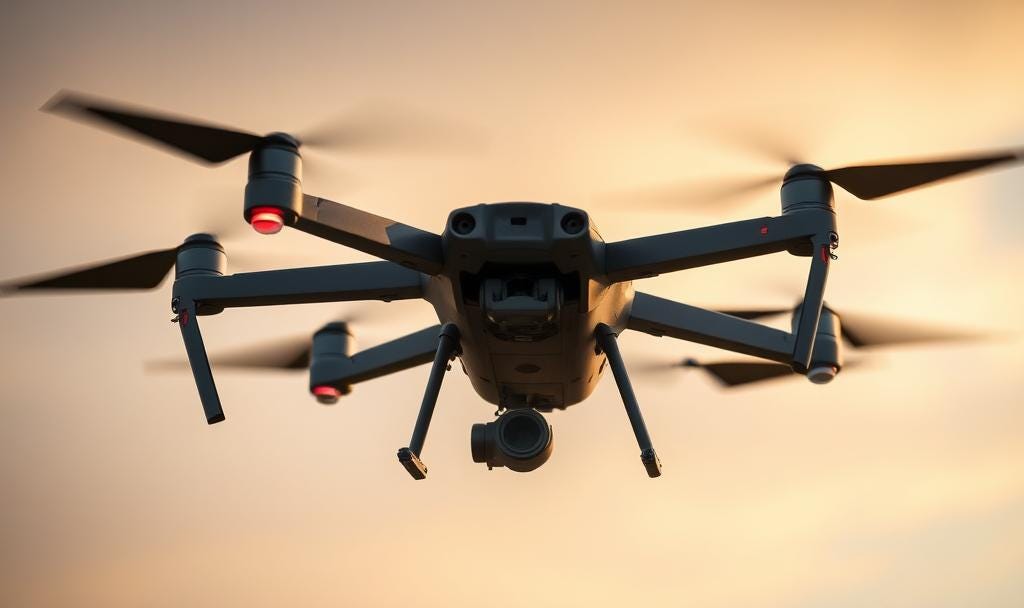Drone Dispatch
22 September - 28 September, 2025
Dronefare Weekly Drone Dispatch
Welcome to the Drone Dispatch, your dedicated source for staying ahead in the rapidly evolving world of drones and drone warfare. This newsletter brings together the latest developments in drones and drone warfare, from cutting-edge technology and tactical innovations to global military applications and policy shifts. Each dispatch is designed to provide a clear and concise overview of how drones are shaping modern conflict, international and domestic security, and strategy.
Executive Summary
Russia’s latest attack in Ukraine involved nearly 600 drones and dozens of missiles.
Ukraine is striking deeper into Russian territory via drone attacks on military factories.
European states, led by the UK, are rushing to deploy a “drone wall” to counter cross-border incursions, especially near military and infrastructure sites.
Denmark has responded with regulatory restrictions on drone flights near military bases in reaction to recent incursions.
The U.S. is expanding the deployment of Reaper drones in South Korea.
Defense firms are advancing interceptor drone technologies to provide more cost-effective counter-UAS options.
Drone Warfare
Russian Missile and Drone Barrage Kills 4 — Kyiv
Russia launched a massive mixed strike force of drones and missiles on Kyiv, killing at least four and damaging urban infrastructure. Ukraine claimed its air defenses intercepted the bulk of the incoming threats, though some reached populated neighborhoods.
Bryansk-Oblast Factory That Supplies Russia’s Military Reportedly Burns Following Drone Strike
A defense‐industrial facility in the Bryansk region caught fire after a cross-border drone attack, suggesting Ukraine is extending its reach. The strike raises the prospect that supply and logistics assets far from the active combat zone are now at risk.
RSF Amasses Drone Fleet at Nyala, Signals Imminent Offensive
Sudan’s paramilitary Rapid Support Forces (RSF) have staged a deployment of at least 43 attack drones and 36 launchers at the Nyala airbase in South Darfur, in what analysts warn is a sign of an imminent large-scale assault. Among them, 23 resemble Shahed-136 loitering munitions capable of deep strikes across Sudan, putting civilian infrastructure and humanitarian operations at heightened risk.
U.S. Air Force Reaper Drones Expand Presence in South Korea
The deployment of MQ-9 Reaper drones to South Korea aims to enhance surveillance and deterrence capabilities in a potentially contested region. This reflects the U.S. belief that drone assets play a critical role in the Indo-Pacific security environment, implying continued investment in long-endurance ISR platforms in areas of tension.
Drones Circle Turkey-Gaza Aid Flotilla as Boats Sail East
Drones were observed circling aid vessels en route to Gaza. The presence of UAVs complicates the security of civilian relief operations in contested waters.
Ukrainian Drones Downed Over Moscow, Two Civilians Killed
Ukrainian drones targeted Moscow, causing a fire in a residential area that killed two civilians. Moscow intercepted the drones. The risk is that escalation may bring retaliatory drone attacks deep into the adversary’s territory.
Sanaa Forces Claim Hypersonic Missile Strike on Yaffa and Drone Attacks on Umm al-Rashrash
The Yemeni Sanaa government’s armed forces announced they carried out two operations, striking sensitive targets in occupied Yaffa (Tel Aviv) with a “Palestine-2” hypersonic ballistic missile reportedly carrying multiple warheads, and attacking two critical facilities in Umm al-Rashrash (Eilat) using drones. In a statement, they framed the strikes as retaliation for Israeli actions in Gaza, declared the operations successful, and vowed continued support for Palestinian groups until the siege of Gaza ends. These are claims made by Sanaa forces and have not been independently verified in this summary.
Poland Responds to Drone Incursions
Following a significant drone incursion on September 9–10, 2025, Poland invoked Article 4 of the NATO treaty, prompting the launch of Operation Eastern Sentry. The operation involves NATO forces deploying advanced air defense systems, including F-35 fighters and Rafale jets, to protect Poland’s eastern borders and airspace.
Drone Policy & Regulation
Britain to Build ‘Drone Wall’ to Protect Europe From Russia
The UK has announced plans to deploy a “drone wall”, a continuous barrier of sensors and interceptors, to protect NATO’s eastern flank from Russian drone incursions. The concept suggests combining detection, jamming, and kinetic responses across national boundaries.
Denmark Bans Drone Flights Near Military Bases After Recent Sightings
In reaction to repeated drone sightings near military installations and airports, Denmark has prohibited drone operations around those sensitive zones. The measures reflect a tightening of national airspace regulation in response to hybrid threats.
Zelenskyy Proposes Joint Aerial Shield With European Allies
Ukrainian President Zelensky has pitched a cooperative European air-defense network to counter drones and missiles, effectively making Ukraine part of the continental shield. His proposal would require sharing early warning, command and control, and interceptor capacity across borders.
Analysis: Can Europe Fight Back Against Incursions by Drone Aircraft?
Analysts argue that Europe must adopt a layered defense approach combining detection, attribution, and modular counter‐measures rather than relying purely on high-end interceptors. They warn that relying on a single mode of defense risks being overwhelmed by scale or saturation attacks.
UK Anti-Drone Technology Gains Traction After Danish Airspace Incidents
Following drone incidents over Danish infrastructure, the UK is accelerating investment in anti-drone systems and pushing regulatory adaptation to allow deployment in civilian airspace. The effort includes trials of detection radars, jammers, and interceptor drones near airports. However, integrating these systems into shared airspace raises significant legal, safety, and privacy concerns.
Technology & Innovation
Pentagon Awards More Funding to Refine Drone Interceptor Tech for Navy
Projects by firms such as Anduril and Zone 5 have advanced interceptor drone prototypes, earning further funding support from the Defense Innovation Unit (DIU). These systems aim to deliver scalable, lower-cost counter-UAV capabilities for naval and littoral environments.
U.S.–China Drone Warfare: One-for-One Kills?
The U.S. and China appear to be engaged in a tit-for-tat drone escalation, where losses on both sides are matched in near real time. This dynamic tests whether drone warfare becomes a war of attrition or one of adaptation, with each side seeking breakthroughs in stealth, autonomy, and counter-countermeasures.
Autonomous 3D Target Encirclement Enables Drone vs. Drone Engagements
Researchers have proposed a technique for coordinating multiple “guardian” drones to autonomously encircle and intercept enemy UAVs in three dimensions, even under conditions of GPS denial or jamming. The method relies on local coordination algorithms and relative geometry rather than centralized control. If proven in field trials, it could enable drone squads to defend against superior adversary platforms.
Outlook and Future Trends
Advances in artificial intelligence and autonomy are enabling drones to operate with increasing independence, from identifying and prioritizing targets to executing complex missions without continuous human oversight.
Another emerging trend is the deployment of drone swarms coordinated through sophisticated AI algorithms. These swarms enable forces to overwhelm adversary defenses by saturating detection and interception systems, creating new tactical possibilities on land, sea, and in the air. Nations such as China are actively researching swarm applications for both offensive and defensive operations. Future battles may increasingly be determined by the ability to manage large, coordinated drone formations rather than individual platforms.
In response to these threats, layered defense strategies, such as the UK and European “drone wall,” are being explored. By combining sensors, jammers, and kinetic interceptors into integrated networks along borders, such initiatives aim to detect, attribute, and neutralize incursions before they penetrate critical areas.
At the same time, drone design is becoming increasingly modular and versatile, with hybrid airframes and interchangeable payloads allowing rapid adaptation to varied operational requirements. The market for military drones is continuing to expand rapidly, driven by technological advancements in guidance systems, endurance, and precision strike capabilities. As drones proliferate, militaries face both opportunities to enhance situational awareness and offensive capabilities and the urgent need to develop robust countermeasures.
What is the European “Drone Wall”?
The “drone wall” is a proposed initiative led by the United Kingdom to protect Europe from increasingly frequent drone incursions, particularly those originating from Russia. The concept envisions a continuous network of detection and defense systems along key borders, combining radars, sensors, electronic jammers, and interceptor drones to identify and neutralize hostile drones before they reach critical areas. The goal is to create a visible and coordinated layer of protection that can respond rapidly to threats while minimizing damage to civilian populations and infrastructure.
There are challenges, however, including the cost of deployment, maintaining interoperability among different national systems, and adapting to the evolving tactics of adversaries, who may use stealth, swarming, or electronic countermeasures. Implementing a drone wall requires multiple European nations to share intelligence, coordinate response protocols, and integrate their air defense capabilities.
For the drone wall to succeed, it will require adaptability, including upgrades to counter stealth, decoys, and jammers, as well as redundancy to withstand sustained attacks. Ultimately, its effectiveness will rest not just on technology but on the willingness of European allies to share intelligence, cede some sovereignty in defense, and continually invest in the system.
Thanks for reading Dronefare’s Weekly Drone Dispatch. Follow us on LinkedIn and subscribe to stay up-to-date on the latest developments in drone warfare.



